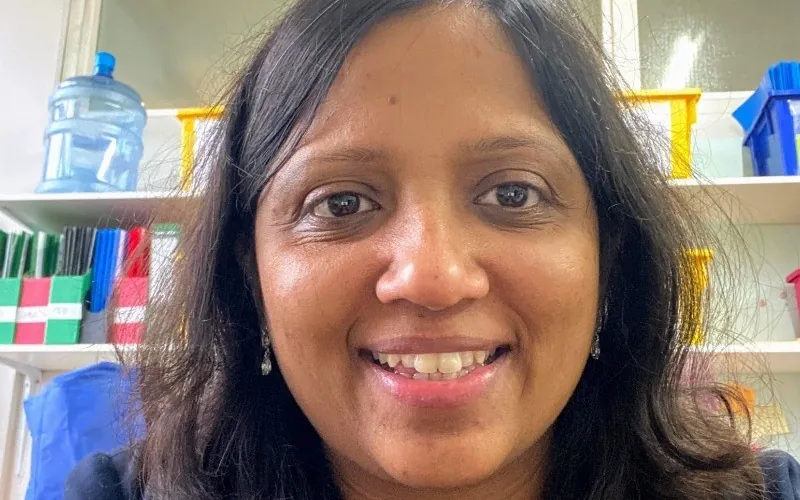A startup aiming to transform how students and professionals are assessed is gaining momentum, with its AI technology now marking free-text answers as accurately as a human – and in seconds.
London-based EdTech sAInaptic, co-founded by former teacher Kavitha Ravindran, has developed an AI model that reads and scores open-ended responses, offering detailed feedback and helping learners improve immediately.
Originally built for schools, the tech is now attracting strong interest from businesses, training providers and awarding bodies – a market that Ravindran says is ripe for growth.
“2024 marked a pivotal moment for sAInaptic,” she told BusinessCloud.
“While automating assessments beyond the school sector was always part of our long-term roadmap, we initially planned to implement it a few years down the line. However, the rise of OpenAI has led to increased awareness around AI-driven solutions, providing us with a unique opportunity to accelerate our plans.
“This shift wasn’t just about timing—it also led to a new strategic direction for the company. This decision was driven by the growing demand for automated assessment solutions from businesses, awarding organisations, and training providers seeking to streamline their assessment processes and reduce costs.
“As part of this expansion, we also enhanced our AI model to meet the specific needs of these clients, ensuring our product was scalable and capable of delivering accurate, high-quality feedback.
“By adapting our approach in response to the accelerating AI trend, we were able to introduce sAInaptic’s solutions to the B2B market earlier than anticipated, positioning ourselves as a reliable solution for the automation of free-text responses in this sector.”
Schools vs businesses
sAInaptic’s platform can plug into a school’s or company’s existing systems through a simple API, or be used as a standalone cloud-based app.
Although it continues to grow in the school market, especially for GCSE and A-level science, Ravindran says the real growth opportunity lies in the business world.
“Several key factors contribute to the B2B market being a more promising avenue for us,” she explained.
“There is a demand for automation, as awarding organisations, course providers, and corporate training departments face complex assessment processes that require scalable and efficient solutions.
“Cost and time savings are also a key factor. Automating assessments reduces operational costs and frees up human assessors, allowing businesses to scale their training programmes or reallocate resources to higher-value tasks.
“Ease of integration is another contributor and our AI-driven assessment technology can be seamlessly integrated into existing systems via APIs or Learning Management Systems (LMS), making adoption straightforward for businesses.
“While the school sector will continue to grow, particularly as we expand into more subjects and year groups, it remains a challenging market due to evolving stakeholder needs and budget constraints.
“That said, as the product matures and demonstrates a measurable impact on learning outcomes, we anticipate steady growth in both sectors, with B2B leading the way in scalability and adoption.”
‘The best thing a business can do is forget AI exists’ – tech CEO
The AI evolution
Advances in large language models (LLMs) – the technology behind ChatGPT – have helped push sAInaptic’s capabilities even further, especially for nuanced or complex responses.
But Ravindran was quick to point out that their product isn’t just built on generic AI.
She said: “Our AI model doesn’t rely solely on LLMs. We’ve adopted a hybrid framework, where LLMs are used selectively, depending on the specific needs of each assessment type.
“This allows us to maintain full control over the accuracy of marking and feedback, while also offering cost-effective solutions to our clients.
“Our in-house team of AI engineers and data scientists design the core algorithm, combining it with LLM capabilities to train the AI model. This approach enables us to fine-tune the model, ensuring consistent marking quality across various assessment types.
“By leveraging the best of both worlds – utilising LLMs when appropriate, while retaining control through our proprietary algorithms – we can ensure our B2B product evolves alongside technological advancements, providing scalable, future-proof solutions that save time, reduce costs, and improve learner outcomes.”
From classroom to code
Ravindran’s journey into EdTech is far from typical. She started her career as a Montessori teacher before teaching science at secondary level – an experience that now shapes her vision for the company.
“The shift from early years to AI in assessments might seem unexpected, but at its core, it’s all about making learning more effective,” said the Bangalore University graduate.
“I’m a huge advocate for AI in education, but I also have a deep respect for traditional teaching methods.
“My Montessori training has influenced the way I think about learning, even as I build AI-driven solutions for classrooms.”
An excAIting future
In the next year, sAInaptic plans to grow its presence in UK schools by adding more subjects to its assessment platform. It is also targeting partnerships with awarding organisations and training providers in the technical and vocational space.
Ravindran continued: “In the next 12 months, we plan to expand our school offering, building on our existing GCSE science product by extending it to A-levels and adding other subjects across both GCSE and A-levels. This will increase the breadth and depth of our product, serving a larger pool of students and teachers.
“Additionally, we are focused on partnering with awarding organisations and course providers within the TVET sector, where we aim to help streamline assessment processes.
“Our goal is to ensure that learners receive high-quality, consistent feedback that aligns with the required standards. Beyond just improving assessments, this approach will have a significant impact on employability, enabling young people to enter the skills market with qualifications that meet industry expectations and support career growth.
“We believe that the future of education lies in providing instant, personalised feedback that empowers learners to continuously improve and succeed.
“Our goal is to support both educators and learners by streamlining their assessments and making feedback more meaningful and actionable.”


